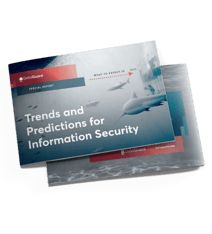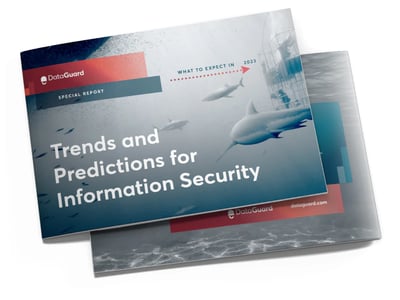With the rise of online threats, information security has become a growing concern for companies worldwide. In fact, according to IBM's recent Cost of a Data Breach Report, the average total cost of a data breach has increased by 12.7% to $4.35 million. This cost includes lost business expenses, legal fees, and regulatory fines.
These statistics serve as a stark reminder of the potential financial and reputational harm that can result from inadequate information security measures, making it imperative for companies to adopt robust security practices.
For CTOs, this means developing and implementing a robust strategy to ensure the safety of their company’s critical data systems and protect them from unauthorised access, misuse, or compromise.
When creating such a strategy, CTOs should always ask questions about every aspect of information security to get a clearer idea of how to build their strategy. In this article, we'll guide you through some of these key questions, why it's critical to act now to protect your company from online threats, and how frameworks like ISO 27001 can help.
Before we get into the development of an information security strategy, let’s see why information security itself is important, especially to CTOs.
Why is information security important to CTOs now more than ever?
Information security has always been a crucial part of business operations for CTOs, but its importance has increased in recent years for several reasons:
- Hackers and other malicious actors are becoming more sophisticated, using social engineering, ransomware, and supply chain attacks to compromise networks and steal sensitive data. A comprehensive security strategy can detect and stop cyberattacks before they cause significant damage.
- Cloud computing has become a widespread tool. It offers many benefits like scalability and cost efficiency; but also introduces new security challenges that include data breaches, insider threats and human error. Implementing adequate security controls can help protect data and applications that are hosted in the cloud.
- Recent data privacy regulations have become more complex. For instance, the EU's GDPR and the USA's CCPA fine companies that fail to protect their citizens' personal data. Compliance with these regulations can prevent major financial and reputational losses.
- Many companies have adopted remote work and digital collaboration tools to maintain business continuity during the COVID-19 pandemic. Cybercriminals can now exploit remote access tools and other online collaboration platforms, so a strategy for remote worker security can prevent unauthorised access to critical systems and data.
These are a few reasons companies should consider implementing a solid information security strategy. But how can you make sure that your strategy is implemented well?
What are key questions CTOs should ask when implementing an information security strategy?
An information security strategy is a comprehensive plan that companies use to protect their sensitive data from unauthorised access, theft, or loss. It is a key part of a company’s risk management strategy and covers the people, processes, and technology involved in information security.
An information security strategy has three main phases: development, management and monitoring. During each step, it’s beneficial for CTOs to ask questions that could help them understand the strategy better. Let’s take a look at some of these questions.
1. Developing the information security strategy
When developing an information security strategy, a CTO must ensure that it aligns with the company’s goals and objectives. To achieve this, CTOs can ask the following questions:
- What IT policies and systems should be in place to support implementing the information security strategy?
This covers aspects such as access control, data classification, and incident response. Systems should include firewalls, intrusion detection systems, and antivirus software.
- How do we ensure that our information security program is aligned with industry best practices and regulations?
This involves conducting regular assessments and audits of the strategy by engaging with external security consultants or auditors familiar with industry standards and regulations. CTOs can also participate in industry-specific information security forums and conferences to stay up-to-date with emerging trends and best practices.
- What are the company's critical assets?
A company's critical assets are the information, systems, and resources that are essential to its operations and can significantly impact its business if compromised. They include sensitive customer data, financial information, intellectual property, proprietary software, and infrastructure like servers and networks.
- What are the potential risks and vulnerabilities, and how will they be mitigated?
Risks and vulnerabilities can come from many sources, including external threats like hackers, malware and phishing attacks and internal threats like accidental or deliberate data breaches by employees. To mitigate them, the strategy has to have security controls like firewalls, encryption, and security awareness training.
- How do we measure the effectiveness of our information security program?
CTOs can monitor metrics such as the number and severity of security incidents, compliance with policies and regulations, employee compliance rates, and the success of security awareness training can be used to measure the effectiveness of the strategy.
2. Managing operations and resources while the strategy is in use
CTOs are responsible for managing the company’s technology infrastructure, hardware, software, networks and servers and ensuring that these resources are properly maintained and updated to minimise the risk of security breaches. The following questions can help them do this effectively:
- How do we prioritise security-related projects and initiatives?
This requires a risk-based approach that considers the potential impact and likelihood of security risks and the resources and budget available to the company. A risk assessment can help identify the company's most vulnerable areas to security threats and prioritise projects and initiatives that address those vulnerabilities.
- How do we allocate resources to ensure that security-related projects are completed on time and within budget?
Project management methods like Agile or Waterfall can be used to ensure that projects are managed effectively and completed on time. Additionally, communication with stakeholders, including senior management, project teams, and business unit leaders, can also help keep everyone aligned on project goals and timelines.
- How do we ensure all employees know their roles and responsibilities in maintaining information security?
Employees should have regular training sessions, ongoing communication and reminders about the importance of information security and the specific policies and procedures they must follow. Training should be tailored to each employee's particular roles and responsibilities and any relevant legal or regulatory requirements. - How are the technology needs of all departments analysed to ensure security requirements are met?
Work with department heads to analyse their technology needs. After the analysis, you may implement security controls like firewalls to protect sensitive data or provide training to employees on cybersecurity best practices.
3. Monitoring and status reporting
CTOs are responsible for monitoring the company’s data network and system logs, security events, and other relevant data to identify any potential threats or vulnerabilities. Here are some questions to ask during this phase:
- How is the company's information security status reported to third parties?
Ensure that documentation and status updates are provided to third parties to demonstrate that the company's information security program is up to standards. This may include compliance reports, security assessments, and vulnerability reports.
- How do you monitor the company's security posture?
To effectively monitor a company's security posture in line with industry standards, conduct regular assessments and reviews of the organization's security controls, policies, and procedures are essential. This involves conducting internal audits by an independent and competent internal auditor, implementing Key Performance Indicators (KPIs), regularly conducting risk assessments, reviewing incident management processes, and conducting regular employee training.
In addition to these steps, monitoring network traffic, conducting vulnerability assessments, and analyzing security logs are also crucial for identifying potential security incidents and enabling a quick response. These measures provide insights into potential vulnerabilities and weaknesses in the security controls, which can then be addressed through the implementation of appropriate measures. - How do we ensure that security incidents are promptly reported and documented?
To do this, clear policies and procedures for incident management must be established, including educating employees on identifying and reporting security incidents and providing a clear channel for reporting incidents. Incident response teams should also be established, and their roles and responsibilities should be clearly defined.
Developing and maintaining an information security strategy is a sensitive task that may have a few challenges. Knowledge of these challenges before development may help you navigate information security better.
What are some challenges faced by CTOs in information security?
Depending on your company and industry, the challenges you face may vary. But here are some common challenges that CTOs in any industry could face when implementing and managing an effective security program:
- Lack of resources - When preparing to manage information security effectively, CTOs often face a lack of resources, including budget, staffing, and infrastructure. Because of these limited resources, it may be challenging to implement robust security measures, conduct regular security assessments, and implement security policies and procedures.
- Complexity - Modern IT infrastructure can be complex, with multiple systems, applications, and devices that must work together. Managing security across all these systems can be difficult, especially when each application requires a unique set of security protocols.
- Human error - Despite having the best security measures in place, human error continues to be one of the leading causes of security breaches. Employees may accidentally reveal sensitive information, fall victim to phishing scams, or fail to adhere to security policies and procedures.
- Evolving threat landscape - The threat landscape is constantly changing, with new types of cyber-attacks emerging daily. CTOs must stay up to date with current security threats and trends and adjust their security programs accordingly. This requires continuous monitoring, regular risk assessments, and proactive measures to address emerging threats.
Overall, these challenges can make it difficult for CTOs to implement and manage an effective information security program. However, there is an all-rounded solution to these challenges.
How can an ISMS and ISO 27001 help?
ISMS stands for information security management system. It is a collection of policies, procedures, and controls that define how a company manages and protects its information assets. The ISMS ensures that a company's information is kept confidential, accessible when needed, and unaltered.
To create a successful ISMS, most companies adhere to international standards such as ISO 27001, which provides a comprehensive framework. It specifies the requirements for developing, implementing, maintaining, and continuously improving an ISMS.
Implementing an ISMS and obtaining ISO 27001 certification can assist CTOs in addressing the following challenges in managing information security:
- Resource Management - An ISMS provides a structured framework for managing information security resources. It helps CTOs identify and allocate resources based on the risks and priorities of the company. By implementing an ISMS, CTOs can make informed decisions on allocating resources to manage risks effectively.
- Simplify Complexity - An ISMS helps simplify security management across complex IT infrastructures by providing a standardised framework for security management. This means that different systems and applications can be managed consistently and effectively.
- Reduce Human Error - An ISMS emphasises the importance of employee training and awareness programs. CTOs can reduce the risk of human error and improve the company's overall security posture by providing employees with regular training on information security best practices and security policies.
- Keep up with Threats - An ISMS requires regular risk assessments, vulnerability assessments, and continuous monitoring. This helps CTOs stay current with emerging threats and implement appropriate risk mitigation controls.
- Compliance - Implementing an ISMS and obtaining ISO 27001 certification demonstrates that the company has controls to manage information security risks. This can help meet regulatory requirements like the NIS2 Directive, which requires companies to establish strong cybersecurity measures to protect against cyber threats.
How can DataGuard help you create a successful information security strategy?
At DataGuard, we offer a comprehensive information security management solution through InfoSec-as-a-Service. Whether you require industry-specific guidance, assistance in establishing your ISMS, or preparing for an external audit, we provide the necessary support to ensure you achieve the desired outcomes.
Additionally, our in-house experts can guide you toward implementing and adhering to ISO 27001 best practices. Through our services you can:
- Get step-by-step guidance from InfoSec experts
- Leverage a user-friendly web-based platform to identify gaps, assess risks and generate ISO-complaint policies
- Build and automate a certified ISMS from scratch
- Adapt procedures and resources to suit the needs of your company
- Establish an External Information Security Officer V-CISO who works closely with your organisation’s senior management team, including the C-suite to provide expert advice on information security matters
Conclusion
As cyber threats continue to evolve, CTOs must prioritise information security and integrate it in their business operations. Despite facing common challenges, CTOs can leverage an ISMS and ISO 27001 to build a successful security program.
By implementing an ISMS and obtaining certification, CTOs can allocate resources effectively, simplify complexity, reduce human error, keep up with threats, and comply with regulatory requirements.
Schedule a meeting today to start planning your information security strategy.


Trends and predictions in InfoSec
Exclusive expert insights into trends and predictions in information security 2023.
Download your copy now






